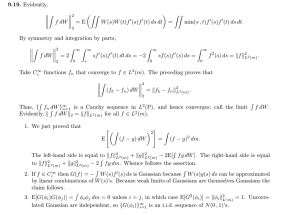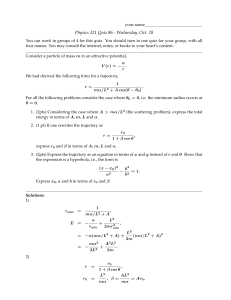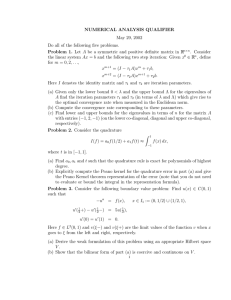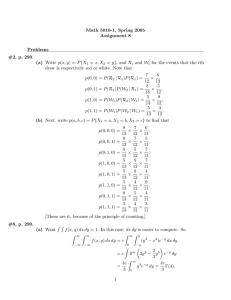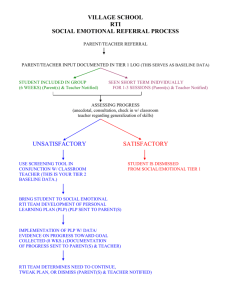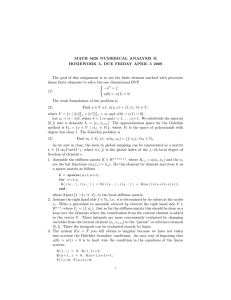Lecture 8 Lp
advertisement
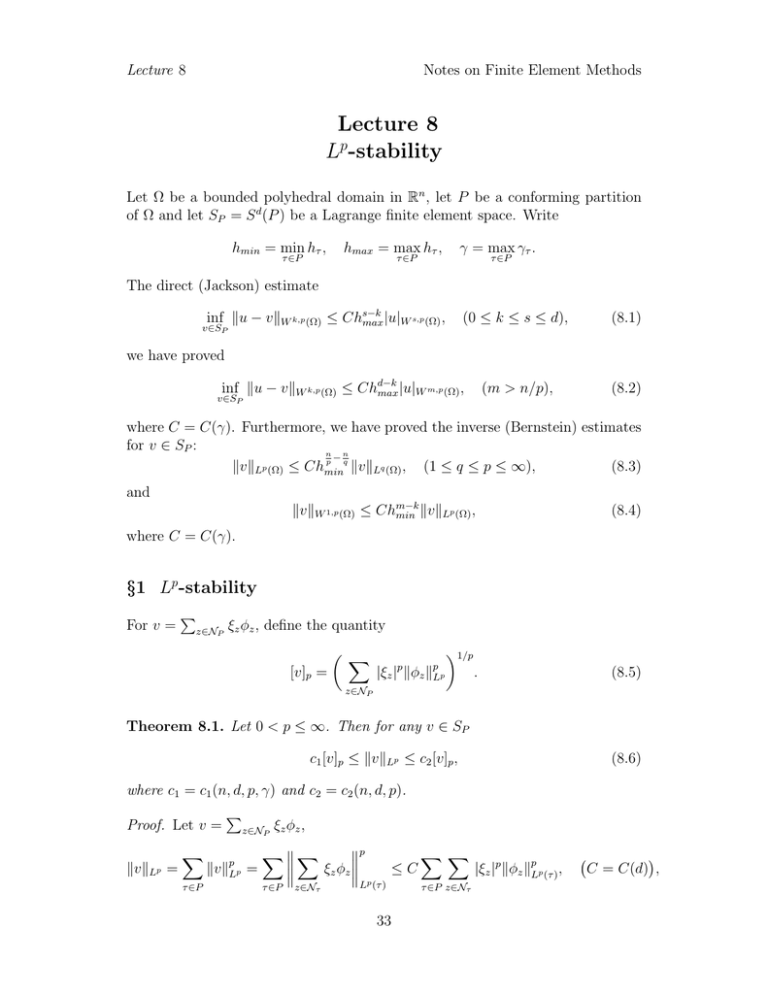
Lecture 8 Notes on Finite Element Methods Lecture 8 Lp-stability Let Ω be a bounded polyhedral domain in Rn , let P be a conforming partition of Ω and let SP = S d (P ) be a Lagrange finite element space. Write hmin = min hτ , τ ∈P hmax = max hτ , γ = max γτ . τ ∈P τ ∈P The direct (Jackson) estimate inf �u − v�W k,p (Ω) ≤ Chs−k max |u|W s,p (Ω) , (0 ≤ k ≤ s ≤ d), v∈SP (8.1) we have proved inf �u − v�W k,p (Ω) ≤ Chd−k max |u|W m,p (Ω) , (m > n/p), v∈SP (8.2) where C = C(γ). Furthermore, we have proved the inverse (Bernstein) estimates for v ∈ SP : n −n p q �v�Lp (Ω) ≤ Chmin �v�Lq (Ω) , (1 ≤ q ≤ p ≤ ∞), (8.3) and �v�W 1,p (Ω) ≤ Chm−k min �v�Lp (Ω) , (8.4) where C = C(γ). §1 Lp -stability For v = � z∈NP ξz φz , define the quantity [v]p = � � z∈NP |ξz | p �φz �pLp �1/p . (8.5) Theorem 8.1. Let 0 < p ≤ ∞. Then for any v ∈ SP c1 [v]p ≤ �v�Lp ≤ c2 [v]p , (8.6) where c1 = c1 (n, d, p, γ) and c2 = c2 (n, d, p). Proof. Let v = �v�Lp = � τ ∈P � �v�pLp ξ z φz , �p �� �� � � � = ξ φ z z � � p z∈NP τ ∈P z∈Nτ L (τ ) ≤C 33 �� τ ∈P z∈Nτ |ξz |p �φz �pLp (τ ) , � � C = C(d) , Lecture 8 Notes on Finite Element Methods by convexity of x �→ xp . Let κz,τ = |ξz |p �φz �pLp (τ ) , it is clear that κz,τ = 0 if τ ∩ supp φz = Ø and � |ξz |p �φz �pLp (τ ) = |ξz |�φz �pLp (ωz ) , (ωz = supp φz ). τ ∈P τ ∩ωz �=Ø We have �v�pLp ≤ C � κz,τ = C τ ∈P z∈NP � � κz,τ = C z∈NP τ ∈P τ ∩ωz �=Ø � z∈NP |ξz |�φz �pLp (ωz ) = C[v]pLp , where C depends on d. Conversely, we want �� �p � � � p � |ξz |�φz �Lp (τ ) ≤ C � ξ z φz � � z∈Nτ , Lp (τ ) z∈Nτ but this is true by scaling τ back to σ and C here will depend on γ. §2 Conditioning Consider the following Poisson problem: � −∆u = f u=0 in Ω on ∂Ω. Consider the finite element space SP = S d (P ) ∩ H01 (Ω). NP only contains the interior nodes. The Galerkin problem (PG) is: a(uP , v) = �f, v� v ∈ SP , where uP ∈ SP and a(·, ·) is the bilinear form a(u, v) = �∇u, ∇v�. Solving (P G) is equivalent to solving the linear system Aξ = η, where Ayz = a(φy , φz ) = �∇φy , ∇φz � , and ηz = �f, φz � , uP = � z∈NP ξ z φz , y, z ∈ NP , z ∈ NP . We pose the following question: Is the condition number κ = �A��A−1 � reasonable? Theorem 8.2. For the matrix A formulated by (PG), � �n hmax −2 c1 hmax ≤ κ ≤ c2 h−2 c1 > 0. min , hmin 34 (8.7) Lecture 8 Notes on Finite Element Methods Proof. Since A is symmetric positive definite (consequence of coercivity), we have λmax = max ξ ξ T Aξ , ξT ξ λmin = min ξ ξ T Aξ . ξT ξ Have �φz �2L2 ≤ Chnmax and �φz �2L2 ≥ Ch2min so by L2 -stability, � Chnmin ξ T ξ ≤ �v�2L2 ≤ C |ξz |2 �φz �2L2 ≤ Chnmax ξ T ξ, z∈NP Moreover, ξ T Aξ = � y,z∈NP so ξy a(φy , φz )ξz = a(v, v) = �∇v�2L2 , �∇v�2L2 �∇v�2L2 ξ T Aξ n · Ch ≤ ≤ · Chnmax . min �v�2L2 ξT ξ �v�2L2 −2 n 2 By Bernstein, �∇v�2L2 ≤ h−2 By Friedrichs, min �v�L2 which makes λmax ≤ hmin hmax . � �n n �∇v�L2 ≥ C�v�L2 which makes λmin ≥ Chmin . We arrive at κ ≤ C hhmax h−2 min . min For the lower bound, take v = φz , �∇φz �L2 ≥ Ch−2 hn . If n ≥ 2, choose z belonging to the largest τ so that �∇φz �2L2 ≥ Chn−2 max so we can conclude λmax ≥ �∇φz �2L2 ≥ Chn−2 max . Take u ∈ Cc∞ (Ω) with u ≡ 1 on some B ⊂ Ω and v = IP u. �∇v�L2 ≤ �∇(v − u)�L2 + �∇u�L2 ≤ hmax |u|W 2,2 + |u|W 1,2 ≤ C, (observe that �∇(v − u)�L2 = |u − IP u|W 1,2 ). We see that λmin ≤ Chnmax which implies κ ≥ Ch−2 max . §3 Interpolation of function spaces Recall the Riesz-Thorin convexity theorem: Let T be a linear operator such that T : Lp1 → Lq1 and T : Lp2 → Lq2 are bounded, then T : Lp → Lq is bounded for 1 1−θ θ = + , p p1 p2 1 1−θ θ = + , q q1 q2 35 (0 < θ < 1). Lecture 8 Notes on Finite Element Methods Example 7. Recall �u ∗ v�p ≤ �u�p �v�1 , �u ∗ v�∞ ≤ �u�p �v�q where 1/p + 1/q = � 1. Define Tv = u ∗ v. Then, T : L1 → Lp and T : Lp → L∞ are bounded, with 1/p + 1/p� = 1. All pairs in line L satisfy boundedness. Hence if 1 1 1 1 1 1 − = 1 − =⇒ + 1 = + , p r q r p q T : Lq → Lr is bounded, that is, we have the Young inequality �u ∗ v�r ≤ �u�p �v�q . � 36
